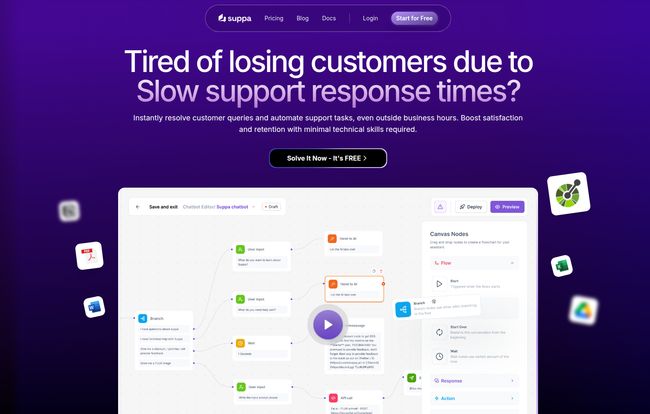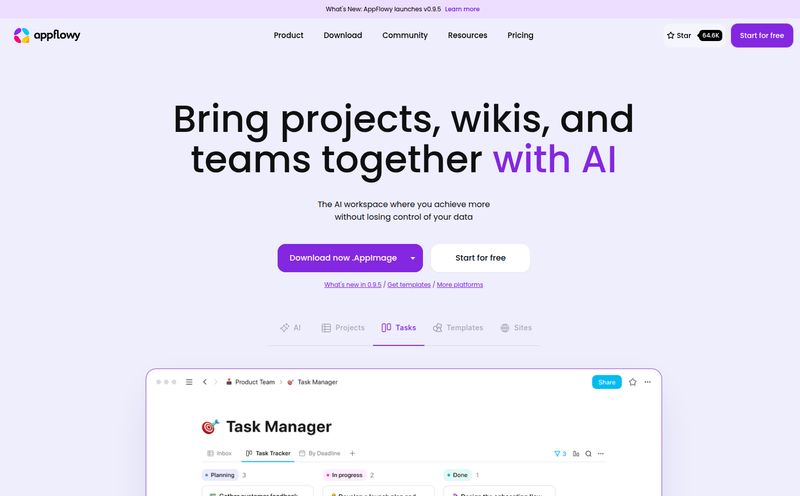I was on hold for 47 minutes last week. Forty. Seven. Minutes. The hold music was a tinny, 8-bit version of a song I think was popular in 2003. By the time a human picked up, I'd forgotten my own name, let alone my account number. We’ve all been there, right? That soul-crushing experience is exactly why businesses are scrambling for better solutions. And the buzzword on everyone’s lips? AI chatbots.
But let's be real. For most small business owners, marketers, or support managers, the idea of building a chatbot sounds about as easy as building a rocket ship in the backyard. It usually means begging your one developer friend for help, sinking thousands into a custom build, or wrestling with tools so complicated they make you want to throw your laptop out the window. So when a tool like Suppa comes along, waving a big “No-Code” flag, my inner skeptic raises an eyebrow. Another one? But this one felt a bit different. Their tagline isn't just about building a chatbot; it's about designing an AI backend. That got my attention.
So, What is Suppa Anyway?
Think of it like this: most chatbot builders give you a mouth. A little pop-up window that can say “Hello, how can I help?” Suppa aims to give you the whole package: the mouth, the brain, and the hands. It's a no-code platform that lets you construct the entire logic center for your AI assistant. You feed it information, you tell it what to do with that information, and then you deploy it wherever you need it—on your website, in your app, you name it.
This isn't just about spitting out pre-written answers from a FAQ page. It’s about creating a system that can genuinely understand a query, fetch the right data from multiple sources, and even perform actions in other systems. All without you needing to know the difference between Python and a python.
The Core Features That Actually Matter
I’ve clicked around a lot of platforms, and most are a sea of jargon. Suppa’s dashboard, from what I can see in their demos, seems refreshingly straightforward. It’s built around a few key ideas that are actually pretty powerful when you put them together.
The No-Code Promise (And Does it Deliver?)
The main event is the visual builder. It looks like you're connecting dots, dragging and dropping elements to create a conversational flow. This is where you design the bot's personality and logic. If a user asks X, do Y. If they mention Z, connect them to this piece of information. For anyone who’s ever tried to map out a customer process on a whiteboard, this should feel pretty intuitive. It’s a far cry from staring at a blinking cursor on a black screen, that's for sure.
Your Chatbot’s Brain: The Knowledge Base
A chatbot is only as smart as the information it has access to. Suppa's approach to this is the “Knowledgebase.” You can feed it all sorts of documents—think PDFs of your product manuals, text from your website's help section, or even just raw text files. The AI then uses this as its library. When a customer asks a question, it doesn't just look for a keyword match; it tries to understand the context and find the most relevant snippet from the library. This is a huge step up from the rigid, keyword-based bots of yesteryear.

Visit Suppa
More Than Just Talk: API Actions
Okay, this is the part that really interests me as a tech guy. The API actions. In simple terms, this is what lets your chatbot do things. It’s the “hands” I mentioned earlier. You can connect Suppa to your other software to:
- Check an order status in your Shopify store.
- Book a demo in your Calendly.
- Create a support ticket in Zendesk.
- Look up customer information in your CRM.
This transforms the bot from a passive information source into an active assistant that resolves issues on the spot. That’s where the real ROI comes from—not just deflecting questions, but completing tasks.
Bringing in the Big Guns: GPT-4o and Claude
For those who follow the AI space, you know that not all AI is created equal. Suppa lets you choose the engine powering your bot, including heavy hitters like OpenAI’s GPT-4o and Anthropic’s Claude 3.5 Sonnet. Why does this matter? It means you're getting state-of-the-art language understanding. These models are incredibly good at grasping nuance, maintaining context in a conversation, and generating human-like responses. Having access to them within a no-code tool is a massive plus.
Let's Talk Money: A Look at Suppa's Pricing
Alright, the all-important question: what’s this going to cost me? The pricing structure seems pretty clear, which I appreciate. No hidden fees or confusing credit systems. They offer a 14-day free trial (no credit card needed, thank you very much) so you can kick the tires before committing.
Here’s a quick breakdown of their monthly plans:
| Plan | Price | Who It's For | Key Limits |
|---|---|---|---|
| Starter | $27 /month | Individuals, solopreneurs, and small businesses just starting out. | 1 Chatbot, 1,000 Chat Sessions, 5 Knowledgebase Items |
| Pro | $57 /month | Growing businesses with more traffic and a need for more bots/integrations. | 3 Chatbots, 3,000 Chat Sessions, 20 Knowledgebase Items |
| Business | $137 /month | Established businesses that need scale, more analytics, and more power. | 10 Chatbots, 10,000 Chat Sessions, 50 Knowledgebase Items |
My take? The Starter plan is perfect for a business owner who wants to put a bot on their main website to handle common questions and capture leads. It’s a low-risk way to get started. The Pro plan feels like the sweet spot for many businesses. Three bots mean you could have one for customer support, one for sales on a specific landing page, and maybe an internal one for your team. The jump in chat sessions and knowledge base items is significant. The Business plan is for when you're serious about automating across multiple departments or products. The higher API limits here are also critical for businesses that want their bot to be a real workhorse. They also offer annual plans which give you a nice little discount if you're in it for the long haul.
The Good, The Bad, and The Realistic
No tool is perfect. As an SEO and traffic guy, I've learned to be pragmatic. Here's my honest breakdown.
What I Really Like
The accessibility is the number one win. The fact that a non-technical person can build something genuinely useful is huge. I'm also really impressed by the focus on API actions; it shows they understand that a chatbot’s value isn't just in talking but in doing. Connecting to different data sources and having a Mobile SDK for apps are also huge differentiators that a lot of simpler tools miss.
Where It Might Fall Short
Okay, let's be real. A no-code platform will never have the infinite flexibility of a custom-coded solution. If you have extremely complex, niche requirements, you might eventually hit a wall. That's the trade-off you make for speed and simplicity. You're also building on their turf, which means you're reliant on Suppa for updates, uptime, and support. For 95% of businesses, this is a total non-issue and actually a benefit, but for large enterprises with rigid compliance needs, it's something to consider.
Final Verdict: Is Suppa Worth Your Time?
After digging through what Suppa offers, I’m genuinely optimistic. This isn’t just another pop-up widget. It feels like a serious tool for building intelligent, automated assistants without needing a computer science degree.
So, who should try Suppa?
- Small Business Owners: Absolutely. This could be your first, tireless customer support agent who never calls in sick.
- Marketing Managers: Yes. Use it to engage visitors on landing pages, qualify leads, and book demos 24/7.
- Support Teams: Definitely. Let a Suppa bot handle the repetitive, tier-1 questions so your human agents can focus on the complex, high-value conversations.
If you're a massive corporation with a team of 50 developers and a multi-million dollar AI budget, you might build your own thing. For everyone else? Suppa seems like a remarkably powerful and accessible entry point into the world of AI automation. It bridges the gap between a simple FAQ bot and a super-expensive custom build. And in my book, that's a pretty valuable place to be.
Frequently Asked Questions
Do I really need coding skills to use Suppa?
Nope, not at all. That's the whole point. The platform is designed with a visual, drag-and-drop interface. If you can make a flowchart, you can build a chatbot in Suppa.
What kind of AI models does Suppa use?
It gives you access to top-tier models like OpenAI's GPT-4 and GPT-4o, as well as Anthropic's Claude models. This ensures your bot has excellent conversational and reasoning abilities.
Can I customize the appearance of my chatbot?
Yes, you can customize the look and feel of the chatbot widget to match your website's branding. The advanced customization options are available on the higher-tier plans.
Can Suppa connect to the other software my business uses?
Yes, through its API actions feature. This allows you to integrate with CRMs, support desk software, scheduling tools, and more, enabling the bot to perform tasks in those systems.
What happens if my chatbot can't answer a question?
You can design flows to handle this. A common solution is to have the chatbot collect the user's information and create a support ticket, or offer a handoff to a live human agent during business hours.
Is there a free trial to test it out?
Yes, Suppa offers a 14-day free trial, and they don't require a credit card to sign up. This lets you explore the platform and even build a basic bot to see if it fits your needs before paying anything.
Conclusion
The days of making customers wait on hold to a terrible 8-bit soundtrack are numbered. Tools like Suppa are democratizing AI, putting real power into the hands of businesses that need it most. It’s not magic, but it's close. It's a practical, powerful, and surprisingly easy way to improve your customer experience, boost your efficiency, and maybe, just maybe, grow your business without having to hire a whole new team. For that, it definitely gets a nod of approval from me.



